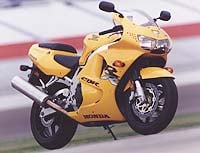1998 Honda CBR 900 RR - Motorcycle.com
Light. Twitchy. Unsettled. Peaky. What do these words all have in common? They were frequently used to describe the last incarnation of Honda's top-shelf sportbike, the CBR900RR. So when the 1998 specs came floating across our desk claiming more horsepower, less weight and more predictable handling for the new Fireblade, we were skeptical. And we wondered if it still had the 16-inch front wheel.
Well, yes, the 16-inch wheel is making a return, but that's only the beginning. American Honda dragged us kicking and screaming (yeah, right) out to the Las Vegas Motor Speedway, first for two days of Freddie Spencer's High Performance Riding School and then for a full day of riding the new 900RR on the AMA Superbike track -- high banks and all.
Although we were hesitant to believe it, the truth of the matter is the new CBR900RR rocks! A few seemingly inconsequential tweaks to engine and chassis have combined to make an animal of an entirely different stripe.
The two peskiest demons of the '96-'97 versions of CBR900RR were its very flexible chassis and lightning-quick steering geometry. Some street riders disliked its twitchy steering, while racers didn't care for the flex when railing through corners. Honda clearly hopes to make all parties happy with the new, 1998 setup.
About 17 percent less flex in the chassis as a whole (close to 40 percent in the new tapered swingarm) and a bit more trail makes for a planted-yet-flickable ride, enjoyed immensely by both sportbike-initiate Associate Editor Billy (cool-I-dragged-knee) Bartels and seasoned racer Editor-in-Chief Brent (I've-been-hanging-out-with-Higbee) Plummer, who turned the slowest and fastest laps, respectively, among the assembled journalists.
All this chassis stiffening, coupled with an advanced aerodynamic upgrade, resulted in more pounds. So the engineers at Honda engaged in an aggressive weight-loss plan, shaving pounds off of everything from the engine to the new eight-plate clutch to the wafer-thin instrument panel. In the end Honda claims the machine is now seven pounds lighter than the 1997 model. Other enhancements include solid-lubed pistons, new, authoritative front brakes, and a larger, curved radiator.
Honda thoughtfully brought along several '97 RRs for comparison. Hands down, the 1998 version spanks the old one. Leaving the garage, the first thing noticed is a crisper throttle response.
Throwing it at the curves and banks of the Las Vegas Speedway, you are greeted (depending on your style and skill level) by both an extremely light-feeling machine that pulls strongly off corner exits (for the recent race school grad) and a predictable mount that cleanly slides the rear out of aggressively attacked corners (the racer-type).
After riding the '98 RR, our neophyte sport-rider gave the '97 about four laps before returning and hopping back on a '98. On sweepers, Bartels complained of tucking the front with the '97 mount when he didn't get on the gas quite soon enough. Boss-man Plummer didn't even give it that many laps.
He still had fever dreams from our 9 Vs. 9 shootout, and complained that the '97 900RR just didn't hold a line like the '98. While the old 'Blade is arguably a quicker-turning bike, the '98 features increased stability and forgiveness, allowing its pilot to slam it into corners without a worry. Besides, it's silly to call any 400-pound bike 'slow turning.'
All we can say is that with the 1998 CBR900RR, a little bit goes a long way. Congratulations Honda, but what took so long?
Look for the new CBR900RR and the other sportbike illuminati (GSX-R750, YZF-R1, ZX-9R and others ) in our ultimate sportbike challenge, coming in February to a browser near you.
Taming the beast: 5mm more trail means the fork tubes are 5mm closer to the frame (trail is the distance, measured on the ground, between the center of the front wheel and a line drawn out from the steering head that meets the ground in front of the wheel. Thus, moving the front wheel back adds trail).
This is good: Added trail has been a common modification made by racers to increase stability to previous years' CBR900RRs. The lower triple clamps are now made of aluminum instead of steel and increase fork span 10mm, resulting in a 10 percent increase in rigidity.
Gear ratios have been widened up, reducing the amount of shifting needed during street riding -- MO staffers tend to prefer wide-ratio five-speeds with decent midrange power, thus we liked the new ratios, especially since the motor has been made much smoother and more responsive.
Racers, however, will want the closer ratios offered last year.
Specifications:
Manufacturer: HondaModel: 1998 CBR900RRPrice: 95.00Engine: Liquid cooled, inline four-cylinder DOHC; four valves per cylinderCompression ratio: 11.1:1Bore and Stroke: 71 x 58mmDisplacement: 919 ccCarburetion: (4) 38mm flat slide CVTransmission: Close ratio 6-speedWheelbase: 55.1 inSeat Height: 32.2 inFuel Capacity: 4.8 gal including .9 gal reserveClaimed Dry Weight: 396.8 lbs
More by MO Staff













































Comments
Join the conversation